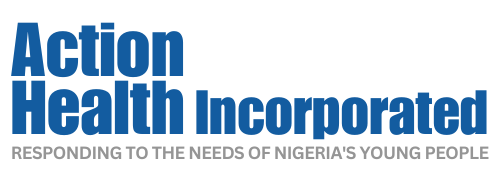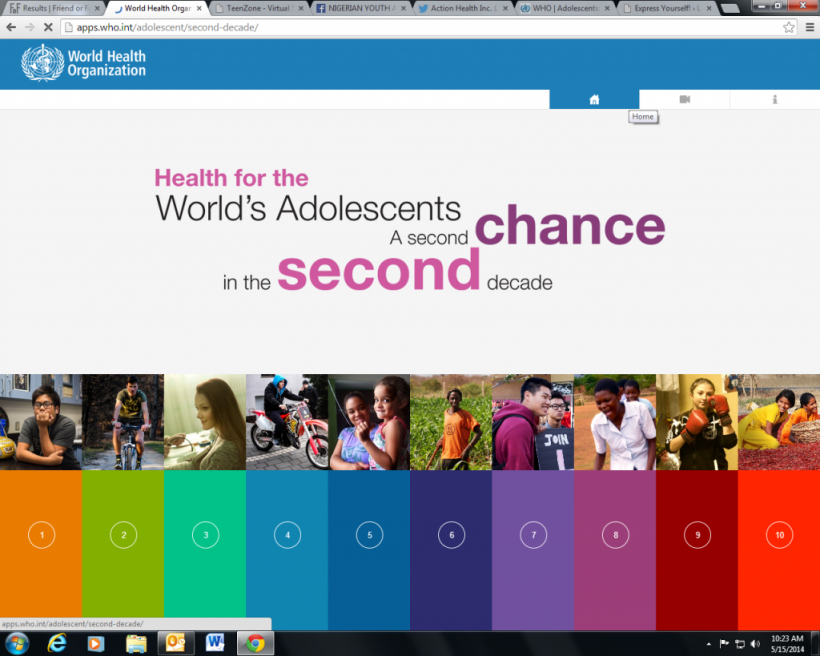In May 2014, WHO published a major report called “Health for the world’s adolescents”. The report analyses what is known about adolescents’ health, including what promotes or undermines it, highlights gaps in policies and services, and draws together guidance and recommendations from across WHO. The report, which focuses on the health sector, examines areas of significant improvements and innovative approaches.
Overall, WHO carries out a range of functions to improve the health of young people, including:
- Drawing up evidence-based guidelines to support health services and other sectors;
- Making recommendations to governments on adolescent health and adolescent friendly health services;
- Raising awareness of health issues for young people among the public and special groups.
FACTS:
-
An estimated 1.3 million adolescents died in 2012, mostly from preventable or treatable causes.
-
Road traffic injuries were the leading cause of death in 2012, with some 330 adolescents dying every day.
-
Other main causes of adolescent deaths include HIV, suicide, lower respiratory infections and interpersonal violence.
-
Globally, there were 49 births per 1000 girls aged 15 to 19, according to 2010 figures.
-
Half of all mental health disorders in adulthood appear to start by age 14, but most cases are undetected and untreated.
Adolescents
Around 1 in 6 persons in the world is an adolescent: that is 1.2 billion people aged 10 to 19.
Most are healthy, but there is still significant death, illness and diseases among adolescents. Illnesses can hinder their ability to grow and develop to their full potential. Alcohol or tobacco use, lack of physical activity, unprotected sex and/or exposure to violence can jeopardize not only their current health, but often their health for years to come.
Promoting healthy practices during adolescence, and taking steps to better protect young people from health risks are critical for the prevention of health problems in adulthood, and for countries’ future health and social infrastructure.
Main health issues include:
Early pregnancy and childbirth
Complications linked to pregnancy and childbirth are the second cause of death for 15-19-year-old girls globally.
Some 11% of all births worldwide are to girls aged 15 to 19 years, and the vast majority are in low- and middle-income countries. The 2014 World Health Statistics put the global adolescent birth rate at 49 per 1000 girls this age – country rates range from 1 to 229 births per 1000 girls. This indicates a marked decrease since 1990. This decrease is reflected in a similar decline in maternal mortality rates among 15-19 year olds.
One of the Millennium Development Goals, MDG 5, is to achieve universal access to reproductive health, for which one of the indicators is the pregnancy rate among the 15 to 19 age group.
Better access to contraceptive information and services can reduce the number of girls becoming pregnant and giving birth at too young an age. Laws that specify a minimum age of marriage at 18 and which are enforced can help.
Girls who do become pregnant need access to quality antenatal care. Where permitted by law, adolescents who opt to terminate their pregnancies should have access to safe abortion.
HIV
More than 2 million adolescents are living with HIV. Although the overall number of HIV-related deaths is down 30% since the peak 8 years ago, estimates suggest that HIV deaths among adolescents are rising. This increase, which has been predominantly in the WHO Africa Region, may reflect the fact that although more children with HIV survive into adolescence, they do not all then get the care and support they need to remain in good health and prevent transmission. In sub-Saharan Africa only 10% of young men and 15% of young women aged 15 to 24 are aware of their HIV status.
MDG 6 to halt the spread of HIV/AIDS has indicators including the prevalence among 15 to 24 year olds and the proportion of this age group with comprehensive correct knowledge of HIV/AIDS.
Young people need to know how to protect themselves and have the means to do so. This includes being able to obtain condoms to prevent sexual transmission of the virus and clean needles and syringes for those who inject drugs. Better access to HIV testing and counselling is also needed.
Other infectious diseases
Thanks to improved childhood vaccination, adolescent deaths and disability from measles have fallen markedly – for example, by 90% in the African Region between 2000 and 2012. But diarrhoea, lower respiratory tract infections and meningitis are among the top 10 causes of death for 10 to 19 year olds.
Mental health
Depression is the top cause of illness and disability among adolescents and suicide is the third cause of death. Violence, poverty, humiliation and feeling devalued can increase the risk of developing mental health problems.
Building life skills in children and adolescents and providing them with psychosocial support in schools and other community settings can help promote good mental health. Programmes to help strengthen ties between adolescents and their families are also important. If problems arise, they should be detected and managed by competent and caring health workers.
Violence
Violence is a leading cause of death. An estimated 180 adolescents die every day as a result of interpersonal violence. Around 1 of every 3 deaths among adolescent males in the low- and middle-income countries in the WHO Americas Region is due to violence. Globally, some 30% of girls aged 15 to 19 experience violence by a partner.
Promoting nurturing relationships between parents and children early in life, providing training in life skills, and reducing access to alcohol and firearms can help to prevent violence. Effective and empathetic care for adolescent survivors of violence and ongoing support can help deal with the physical and the psychological consequences.
Alcohol and drugs
Harmful drinking among adolescents is a major concern in many countries. It reduces self-control and increases risky behaviours, such as unsafe sex. It is a primary cause of injuries (including those due to road traffic accidents), violence (especially by a partner) and premature deaths. It also can lead to health problems in later life and affect life expectancy.
Setting a minimum age for buying and consuming alcohol and regulating how alcoholic drinks are targeted at the younger market are among the strategies for reducing harmful drinking. Drug use among 15 to 19 year olds is also a concern.
Injuries
Unintentional injuries are a leading cause of death and disability among adolescents. In 2012, some 120 000 adolescents died as a result of road traffic accidents. Young drivers need advice on driving safely, while laws that prohibit driving under the influence of alcohol and drugs need to be strictly enforced. Blood alcohol levels need to be set lower for teenage drivers. Graduated licences for novice drivers with zero-tolerance for drink-driving are recommended.
Drowning is also a major cause of death among adolescents – 60 000, two-thirds of them boys, drowned in 2012.
Malnutrition and obesity
Many boys and girls in developing countries enter adolescence undernourished, making them more vulnerable to disease and early death. The number of adolescents who are overweight or obese is increasing in both low- and high-income countries.
Exercise and nutrition
Available survey data indicate that fewer than 1 in every 4 adolescents meets the recommended guidelines for physical activity – 60 minutes of moderate to vigorous physical activity daily.
Anaemia resulting from a lack of iron affects girls and boys, and is the third cause of years lost to death and disability. Iron and folic acid supplements help to promote health before adolescents become parents.
Developing healthy eating and exercise habits at this age are foundations for good health in adulthood. Reducing the marketing of foods high in saturated fats, trans-fatty acids, free sugars, or salt and providing access to healthy foods and opportunities to engage in physical activity are important for all but especially children and adolescents.
Tobacco use
The vast majority of people using tobacco today began when they were adolescents. Prohibiting the sale of tobacco products to minors and increasing the price of tobacco products through higher taxes, banning tobacco advertising and ensuring smoke-free environments are crucial. Globally, at least 1 in 10 younger adolescents (aged 13 to 15) uses tobacco, although there are areas where this figure is much higher. Cigarette smoking seems to be decreasing among younger adolescents in some high-income countries.
Rights of adolescents
The rights of children to survive, grow and develop are enshrined in international legal documents. The Committee on the Rights of the Child (CRC), which oversees the child rights convention, in 2013 published guidelines on the right of children and adolescents to the enjoyment of the highest attainable standard of health.
In 2003, the CRC issued guidelines on states’ obligations to recognise the special health and development needs and rights of adolescents and young people. The Convention on the Elimination of Discrimination Against Women (CEDAW) also sets out the rights of women and girls to health and adequate health care.
SOURCE: WHO


Leave a Reply
You must be logged in to post a comment.